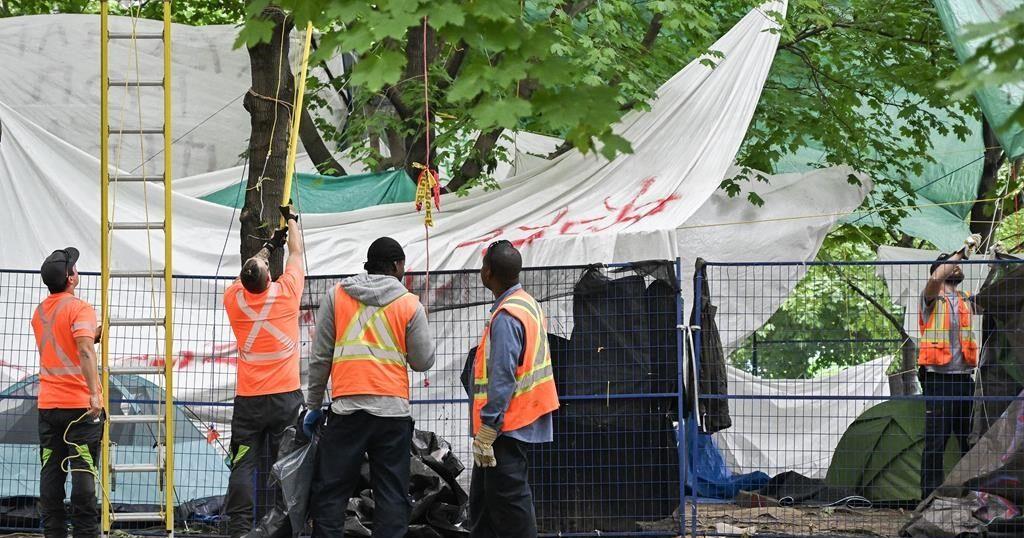MONTREAL – At the City of Montreal’s request, police dismantled a pro-Palestinian encampment in the heart of the financial district on Friday, but the other, larger, occupation — on McGill University’s downtown campus — was left untouched.
Montreal Mayor Valérie Plante told reporters after Victoria Square had been cleared that she used a city bylaw to remove the protesters, whose two-week occupation she said prevented citizens, as well as firefighters and other municipal workers, from accessing a public space.
“We can’t permanently occupy a public site no matter what the cause,” she said. “Public space must remain public.”
And as for the encampment roughly one kilometre north, Plante said it is located on private property. McGill, she added, has to “assume responsibility” for dismantling it. She blamed the university’s “total lack of leadership” for why dozens of protesters have been occupying its campus since late April.
“We are stuck because they chose the way of the courts,” Plante said, referring to the university’s failed attempt to obtain an emergency court injunction to forcibly remove protesters. “They took that path so now they have to be accountable for that.”
Hours earlier, before sunrise, dozens of officers arrived at Victoria Square to clear protesters who had been occupying the park since June 22. Municipal workers cut down metal shielding around tents and tore down tarps. About 15 protesters were moved to the periphery of the square and some were escorted back to the site by police to retrieve belongings. Protesters carried their belongings in crates and on bicycles, as city workers in orange vests loaded trucks with materials collected from the encampment.
Protesters chose Victoria Square because it’s located by the headquarters of the provincial pension fund manager — Caisse de dépôt et placement du Québec. Demonstrators said they wouldn’t leave until the Caisse divested from companies they identified as complicit with Israel, and until the provincial government closed its office in the Middle East country.
Pro-Palestinian protester Emma Jaubert, 20, said about 30 police officers showed up around 5 a.m. at the entrance of the encampment.
“I was at the door … I was the first person that saw them come here,” Jaubert said. “They showed up at the door and were like, ‘You guys are on public space. I have orders from (the city) to dismantle you guys.'”
In contrast to the city’s claim that the dismantlement was peaceful, Jaubert said police acted violently to disperse the protesters.
“When the cops came in they threw one of our comrades on the ground and hit them … they also destroyed several of our tents.”
Later in the day, Plante said the decision to dismantle the encampment was “not taken lightly,” and although protesting is a Charter-protected right, occupying public space to protest cannot be indefinite.
In response to the police operation at Victoria Square, McGill president Deep Saini issued a statement saying he expects Montreal police and the city to “remain consistent in their approach and act swiftly to remove the encampment” on the university’s lower field.
Plante told reporters that McGill has so far failed to negotiate a settlement with protesters, unlike the administration of Université du Québec à Montréal, where demonstrators dismantled their encampment after the university agreed to many of their demands, including to disclose its annual investments and refrain from purchasing securities connected to companies profiting from weapons manufacturing.
Earlier this week, red paint was splashed at the entrance of the offices of the Caisse de dépôt, and a statue inside the nearby World Trade Centre Montréal mall was vandalized. In June, shortly after protesters set up the camp, they tried unsuccessfully to take down the statue of Queen Victoria, located on the square named after the late monarch.
Seized with the vandalism and the length of the occupation at McGill, Public Security Minister François Bonnardel took to X earlier in the week to criticize the city’s “passive approach” to the protesters.
Plante responded Friday, saying she would have preferred the provincial government offer its support instead of making statements on social media.
This report by The Canadian Press was first published July 5, 2024.

























